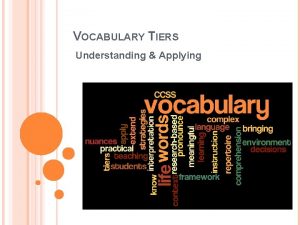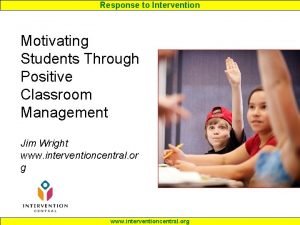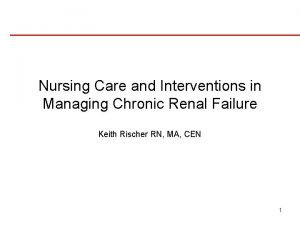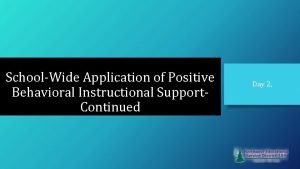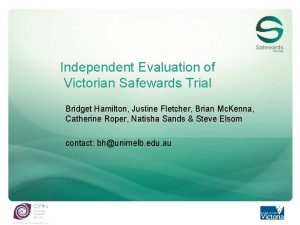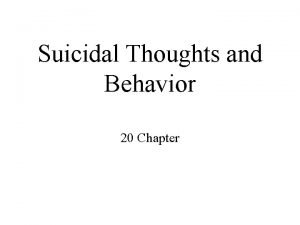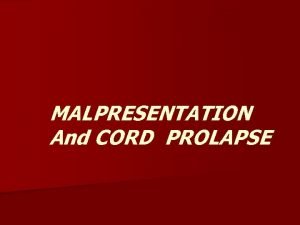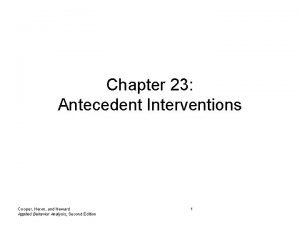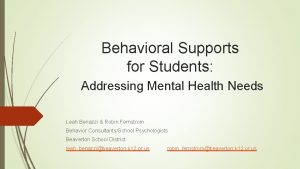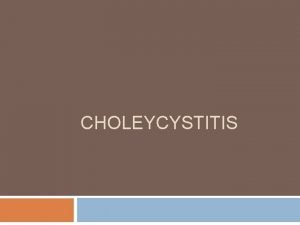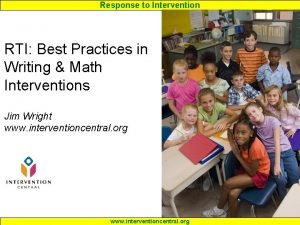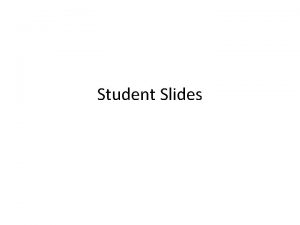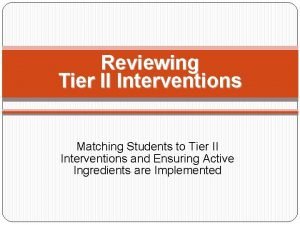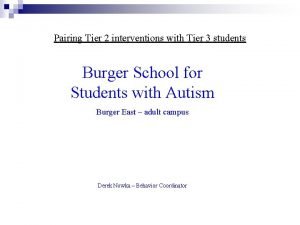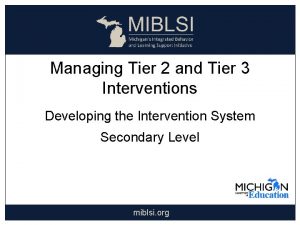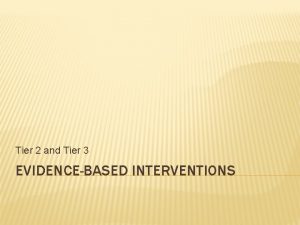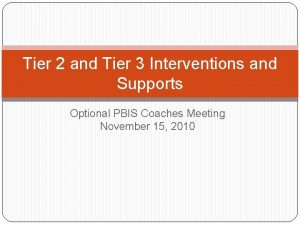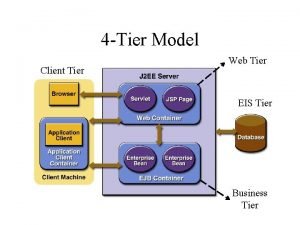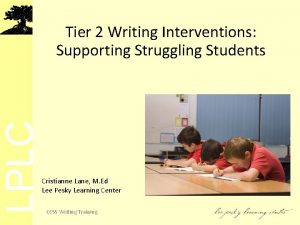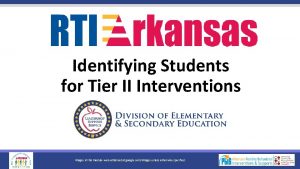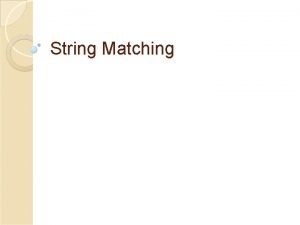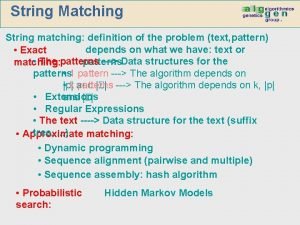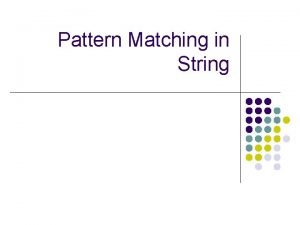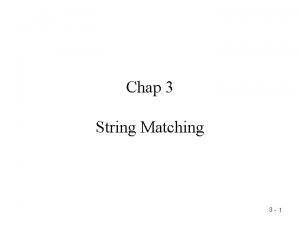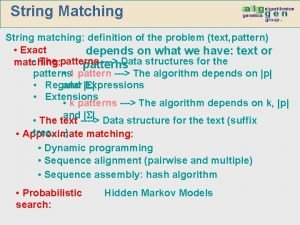Tier II Interventions Matching Students to Tier 2








































- Slides: 40

Tier II Interventions Matching Students to Tier 2 Interventions and Ensuring Active Ingredients are Implemented Diana Browning Wright, MS, LEP Diana Browning Wright, INC Clayton R. Cook, Ph. D University of Washington, Seattle Sound Educational & Psychological Services: . D

MENU of Evidencebased Supports Targeted/ Intensive (High-risk students) Individual Interventions (3 -5%) Selected (At-risk Students) Small Group or Individual Strategies (10 -25% of students) Universal (All Students) School/classwide, Culturally Relevant Systems of Support (75 -90% of students) Tier 2 Menu: • Behavioral contract • Self monitoring • School-home note • Mentor-based program • Class Pass Intervention • Positive peer reporting

Myths About Interventions The Silver Bullet One Size Fits All Interventions are found equally liked by all staff Too little time and not enough staff 3

Matching Students to Tier 2 Interventions Tier 2 intervention are less effective when educators haphazardly assign them to students Rather, educators must ask: what Tier 2 intervention is likely to be most effective for particular students? Matching characteristics of the student to characteristics of the intervention Student Intervention Matching Form (SIM-Form)

Menu of Evidence-based Tier II Interventions TIER II Interventions Mentor-based support* e. g. , Check in/Check out Behavior contracting* Self-monitoring* School-home note system* Dependent group contingency (one student earns for all) First Step to Success Choice-making 5 TIER II Interventions Progress monitoring combined with rewarding goal attainment* Class Pass Intervention* Positive Peer Reporting Academic intervention to address skill deficit Noncontingent Reinforcement Small group social skills or socialemotional learning*

Student Intervention Matching Form

Implementation Involves Active Ingredients Just like a good cooking recipe, Tier 2 interventions involve certain ingredients that must be present in order to achieve successful behavior change Educators, therefore, must be aware of the active ingredients that must be in place to make a particular Tier 2 intervention effective

Selecting the Progress Monitoring Tool Before Beginning Tier 2 Implementation �Existing data behavioral data (class removals, office referral, suspension, attendance record, etc. ) �Direct behavior rating �Point sheet �Brief behavior rating scale

Behavioral Contract Process of negotiating an agreement between staff and a student so each party receives some benefit or payoff Teacher benefits by improved student behavior Student benefits by earning something based on good behavior Behavioral contracts are effective for students who can perform certain behaviors or skills but choose not to do so (i. e. , won’t do problem) Ineffective for students who can’t perform certain behaviors or skills (i. e. , can’t do problems) Must involve daily pre-correction and promoting 9

Behavior Contract: Student Characteristics Designed for students who respond well to school-based incentives Eager to earn rewards, special privileges, and/or recognition from others Students who dislike particular academic subjects and could benefit from receiving extrinsic reinforcement (i. e. , pay-off) Students who could benefit from receiving pre-correction and prompting 10

Behavior Contract: Active Ingredients 1. Negotiated agreement or brokered deal to increase student buy-in 2. Focus on positive behaviors teachers want to see in the classroom (i. e. , those behaviors that are incompatible with problem behavior) 3. Positive reinforcement for meeting goal 4. Teacher follows up with daily pre-correction and prompting Pulling out the contract and reminding the student of the behavior and reward to be earned At the first warning signs of problem behavior, prompting the student 11

Difference Between Effective and Ineffective Behavior Contracts Effective Behavior Contract Negotiated agreement Ineffective Behavior Contract Non-negotiated Describes what the student should Describes what the student is doing Provides a goal statement Provides no goal statement Outlines what the student will earn Outlines how the student will be do as a reward for meeting goal Teacher uses contract to precorrect and prompt behavior 12 wrong punished if problem behavior continues No other adult follow through with the contract


Rate the Intervention Some Students Would Benefit from this Intervention Team’s Receptivity to the Intervention Expected Staff Receptivity to the intervention? 1 = No students 5 = Large number of students 1 = Not acceptable 5 = highly acceptable What needs to be done to prepare for implementation?

Structured Mentor-Based Support: Check in/Check Out Assignment of a mentor who provides unconditional positive regard and feedback on a daily basis Implementation of multiple components: • • Behavioral momentum (i. e. , getting the day off to a good start) Precorrection (i. e. , cutting problems off before they start) Performance feedback (i. e. , letting the student know how s/he is doing) Positive reinforcement (i. e. , recognizing and rewarding the student)

Mentor-Based Support Basic Sequence of Structured Mentoring • Deliver consequences at home based on behavior at school • Provide encouragement for a better day tomorrow Parent Check In upon arrival home Morning check in with mentor • Positive greeting • Deliver praise/reward • Provide nonjudgmental feedback End of day check out with mentor 16 • Positive greeting • Check for school readiness • Cutoff problems before they emerge • Talk about reward to be earned • Give student monitoring chart Teacher evaluation and ongoing feedback • Teacher greeting and monitoring • Prompts to engage in expected behavior • Rating completed

Mentor-Based Support: Student Characteristics Students who respond well to adult attention Students who could benefit from having a positive adult role model outside of the home Students who could benefit from receiving daily encouragement and feedback to improve behavior and school performance Students who have been involved with negative interactions with teachers and administrators (punitive discipline) 17

Mentor-Based Support: Active Ingredients Assignment of an adult mentor who the student likes or doesn‘t mind meeting with Unconditional positive regard (mentor does not get involved with discipline) Daily contact with the student in the morning and afternoon 1. 2. 3. 4. 5. Encouragement, precorrecting problems, feedback Progress monitoring form to serve as a basis for performance-based feedback Positive reinforcement for improved behavior Praise, public recognition, access to desired privileges/rewards 18

Rate Check In/Check Out Tier 2 Students Would Team’s Receptivity to Benefit from this the Intervention Expected Staff Receptivity to the intervention? 1 = No students 5 = Large number of students 1 = Not acceptable 5 = highly acceptable What needs to be done to prepare for implementation?

Self-Monitoring Intervention designed to increase self-management by prompting the student to self-reflect on performance and self-record behavior on a chart Two main components: Self-reflection (reflection of behavior over a certain amount of time) Self-recording (marking down on the chart whether behavior met or did not meet expectations) 20

Self-Monitoring: Student Characteristics Students who lack self-regulation or self-management Students who engage in relatively frequent rates of problem behavior Students who could benefit from reminders or prompts to stay on task and engage in desired, expected behaviors 21

Self-Monitoring: Active Ingredients 1. 2. 3. 4. 5. 6. Identification of positive behaviors to self-reflect upon and self-record on a chart Development of a self-monitoring chart that the students uses to record his/her behavior Prompting - device or natural break that prompts the student to self-reflect and selfrecord behavior Train the student (tell-show-do) Positive reinforcement component attached to self-monitoring chart (increases the value or meaning of self-reflection and recording) Teacher conducts periodic honesty check 22

Self-Monitoring Technology 23 Diana Browning Wright, M. S. , L. E. P. & Clayton R. Cook, Ph. D.

24 Diana Browning Wright, M. S. , L. E. P. & Clayton R. Cook, Ph. D.

25 Diana Browning Wright, M. S. , L. E. P. & Clayton R. Cook, Ph. D.

26 Diana Browning Wright, M. S. , L. E. P. & Clayton R. Cook, Ph. D.

Rate the Intervention Some Students Would Benefit from this Intervention Team’s Receptivity to the Intervention Expected Staff Receptivity to the intervention? 1 = No students 5 = Large number of students 1 = Not acceptable 5 = highly acceptable What needs to be done to prepare for implementation?

School-Home Note System Intervention designed to improve the communication and consistency of practices between school and home environments Involves a parent training component to get parents to deliver consequences at home based on their child’s behavior at school Parent can share information with school about outside stressors that may be impacting student behavior at school 28

School-Home Note Decision Tree COMMUNICATION BEHAVIORAL GOAL MET YES - GOAL MET NO - GOAL UNMET PARENT RESPONSE CELEBRATE YOUR CHILD’S SUCCESS 29 ENCOURAGE YOUR CHILD TO HAVE A BETTER DAY TOMORROW (discipline)

Consequences Delivered by Parents Celebrating the child’s success (aim is to create positive contrast by making the child’s life more exciting, pleasurable, and/or fun) Access to privileges Computer time, video games, talking on the phone, staying up later, hanging out with friends, TV time Reward with item or activity Buy-out of chore, money, invite friend over, play outside, after dinner dessert, playing with toys, etc. Praise and positive recognition 30

Consequences Delivered by Parents Encouraging a better day tomorrow (aim is to create negative contrast by making the child’s life boring, unpleasant, or introducing nothing) Loss of privileges Removal of TV time, computer, video games, playing outside, talking on the phone, or anything else that is considered to be fun Task-based grounding Have the child perform chores that are outside of typical responsibilities Grounded until the chore or chores are completed 31

School-Home Note: Student Characteristics Students whose parents are open and willing to join forces with the school to improve the student’s performance in school Students who are unaffected by typical school-based disciplinary consequences Students whose parents could benefit from learning skills Students who could benefit from consistency across school and home environments 32

School-Home Note: Active Ingredients 1. Development of a school-home note that captures student behavior and communicates with parents Student behavior section, teacher communication section, parent response to note section, parent communication section, & signatures 2. Brief parent training that consists of teaching parents how to translate the information on the school-home note into effective parenting strategies Goal met = celebrating success Goal unmet = encouraging a better day tomorrow 3. 33 Ensuring that parents are receiving the note & following through Paper, email, phone call, face-to-face

Rate the Intervention Some Students Would Benefit from this Intervention Team’s Receptivity to the Intervention Expected Staff Receptivity to the intervention? 1 = No students 5 = Large number of students 1 = Not acceptable 5 = highly acceptable What needs to be done to prepare for implementation?

Class Pass Intervention designed for students who exhibit escape- motivated disruptive classroom behavior to avoid doing academic work Students are given class passes and taught how to appropriately request a break by issuing a class pass Students can choose to hold on to the class passes in order to exchange them for an item, activity, or special privilege It works because students: Exercise choice Increase tolerance for academic work is increased Access to desired activity on an intermittent basis

Example of a Class Pass FRONT BACK Guidelines for Class Pass: # ______ Name: ________ Time: _____ Where to? : __________ Initial: ____________________ If you use the pass… 1. Choose a time when you need to step out of the class. 2. Fill out one of your passes. 3. Show pass to teacher. 4. Walk to __________. 5. Have adult where you walked initial pass on your way back to class. 6. Enter class quietly. 7. Join classroom activity. If you save the pass… Earn a reward!!!!!!!

Class Pass Intervention: Student Characteristics Students who engage in classroom behavior problems only Students whose academic skills are low and are likely to engage in escape- motivated disruptive classroom behaviors Students who have a low tolerance for engaging in academic work Students who appear to become frustrated when working on academic tasks 37 Diana Browning Wright, M. S. , L. E. P. & Clayton R. Cook, Ph. D.

Class Pass Intervention: Active Ingredients Develop the actual class passes to be used Determine the number of class passes and length of time the student can break for Identify the location for the break (desk, in the classroom, outside of the classroom) Identify the items, privileges, or activities that can be earned and the number of class passes needed for each one 1. 2. 3. 4. 38 Diana Browning Wright, M. S. , L. E. P. & Clayton R. Cook, Ph. D.

Rate the Intervention Some Students Would Benefit from this Intervention Team’s Receptivity to the Intervention Expected Staff Receptivity to the intervention? 1 = No students 5 = Large number of students 1 = Not acceptable 5 = highly acceptable What needs to be done to prepare for implementation?

Thank You! Feel free to Contact Me: Diana Browning Wright 626 -487 -9455 dbrowningw@gmail. com 40
 Tiered vocabulary pyramid
Tiered vocabulary pyramid Tier 1 words
Tier 1 words Tier 1 interventions examples
Tier 1 interventions examples Interventions for unmotivated students
Interventions for unmotivated students Why rizal called champion of filipino students
Why rizal called champion of filipino students Contraindications of colostomy
Contraindications of colostomy Organizational development interventions examples
Organizational development interventions examples Disequilibrium syndrome nursing interventions
Disequilibrium syndrome nursing interventions Risk for venous thromboembolism nanda
Risk for venous thromboembolism nanda Gout nursing care plan
Gout nursing care plan Fall prevention interventions
Fall prevention interventions Safewards posters
Safewards posters Positive behavioral interventions and supports
Positive behavioral interventions and supports Safewards 10 interventions
Safewards 10 interventions Maintenance organisation
Maintenance organisation Arthritis care plan ppt
Arthritis care plan ppt Sad persons scale
Sad persons scale Biomechanical interventions
Biomechanical interventions N
N Techno structural interventions
Techno structural interventions Antecedent interventions
Antecedent interventions Define nursing process
Define nursing process Mental health skill building interventions examples
Mental health skill building interventions examples Antecedent based interventions
Antecedent based interventions Nursing care plan for ocd
Nursing care plan for ocd Nursing diagnosis for cholecystitis
Nursing diagnosis for cholecystitis Testicular cancer nursing interventions
Testicular cancer nursing interventions Nursing diagnosis for pancreatitis
Nursing diagnosis for pancreatitis Nursing care plan for pe
Nursing care plan for pe Hypochloremia nursing interventions
Hypochloremia nursing interventions Occupational therapy intervention plan for hip arthroplasty
Occupational therapy intervention plan for hip arthroplasty Venous interventions
Venous interventions Fall prevention interventions
Fall prevention interventions Romberg stance
Romberg stance What is the third step of the nursing process
What is the third step of the nursing process Rti interventions list
Rti interventions list Nursing interventions for thyroid storm
Nursing interventions for thyroid storm Interventions
Interventions Aspiration risk nursing diagnosis
Aspiration risk nursing diagnosis Cingulate herniation
Cingulate herniation Large scale interventions
Large scale interventions
